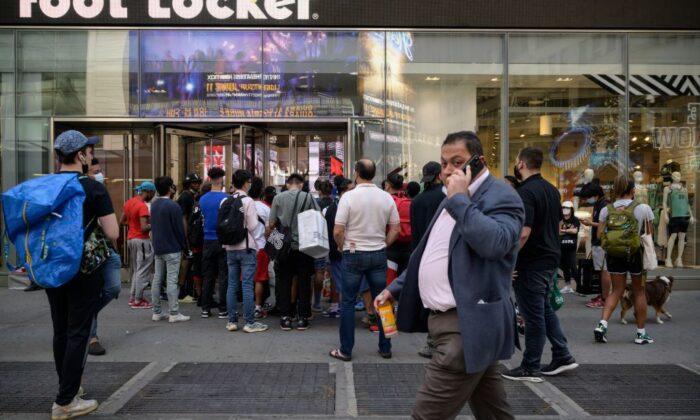U.S. consumer confidence dipped slightly in January, with many consumers planning to purchase items such as homes, appliances, and automobiles, as U.S. businesses face a hit from inflation and the Omicron coronavirus variant.
Consumer confidence in the economy generally remains high in the United States, despite surging prices and scattered shortages of goods and services. The Conference Board’s consumer confidence index survey from Jan. 25, which takes into account consumers’ assessment of current conditions and their future outlook, fell to 113.8 in January, from 115.2 in December 2021.
The survey shows that consumers’ concerns regarding inflation have moderated for a second straight month, after inflation fears hit a 13-year high in November 2021.
The board’s present situation index, which measures consumers’ assessment of current business and labor conditions, rose this month to 148.2 from 144.8 in December 2021. The expectations index, based on consumers’ six-month outlook for income, business, and labor market conditions, fell in January to 90.8 from 95.4 in December 2021.
“Both confidence and consumer spending may continue to be challenged by rising prices and the ongoing pandemic,” said Lynne Franco, senior director of economic indicators at The Conference Board.
The index had ranged from a high of 128.9 this past summer after a lull in the COVID-19 pandemic to as low as 85.7 at the beginning of the pandemic.
In January, the Labor Department reported that inflation rose at its fastest pace in nearly 40 years in December 2021, increasing by 7 percent year-over-year. However, consumers are showing less optimism about business and labor market conditions in the short term.
The wave of Omicron variant cases has slowed the economy, as millions of workers have gotten sick and have had to take time off from work. The good news is that Omicron cases have recently begun to fall, with plentiful jobs and rising wages being available.
Business leaders say there’s plenty of demand for their goods and services, and they expect the economy to speed up again. U.S. consumers over the next six months are looking to spend more on big-ticket items, as prices have risen sharply for gas, food, and furniture, according to The Conference Board.
Strong housing price inflation was mirrored by a fourth report from the Federal Housing Finance Agency that shows housing prices increasing by 17.5 percent in the 12 months through November 2021 after rising by 17.4 percent in October 2021.
There was a massive rise in annual price growth in the Mountain, West South Central, East South Central, and South Atlantic states, with Florida, as well as other metropolitan areas in the Southeast and Southwest regions, reporting strong price growth in November 2021.
The most popular destinations were Miami; Phoenix; Las Vegas; Sacramento, Calif.; and Tampa, Fla.
The number of consumers planning to buy motor vehicles was the largest in six months. An increase was seen in the purchase of household appliances such as television sets and refrigerators, but those of washing machines and dryers fell.
On Jan. 26, the Federal Reserve is expected to announce its intent to begin raising interest rates in mid-March for the first time in three years to combat inflation.
Some economists have expressed concern that the Fed is already moving too late to control surging prices.






Friends Read Free